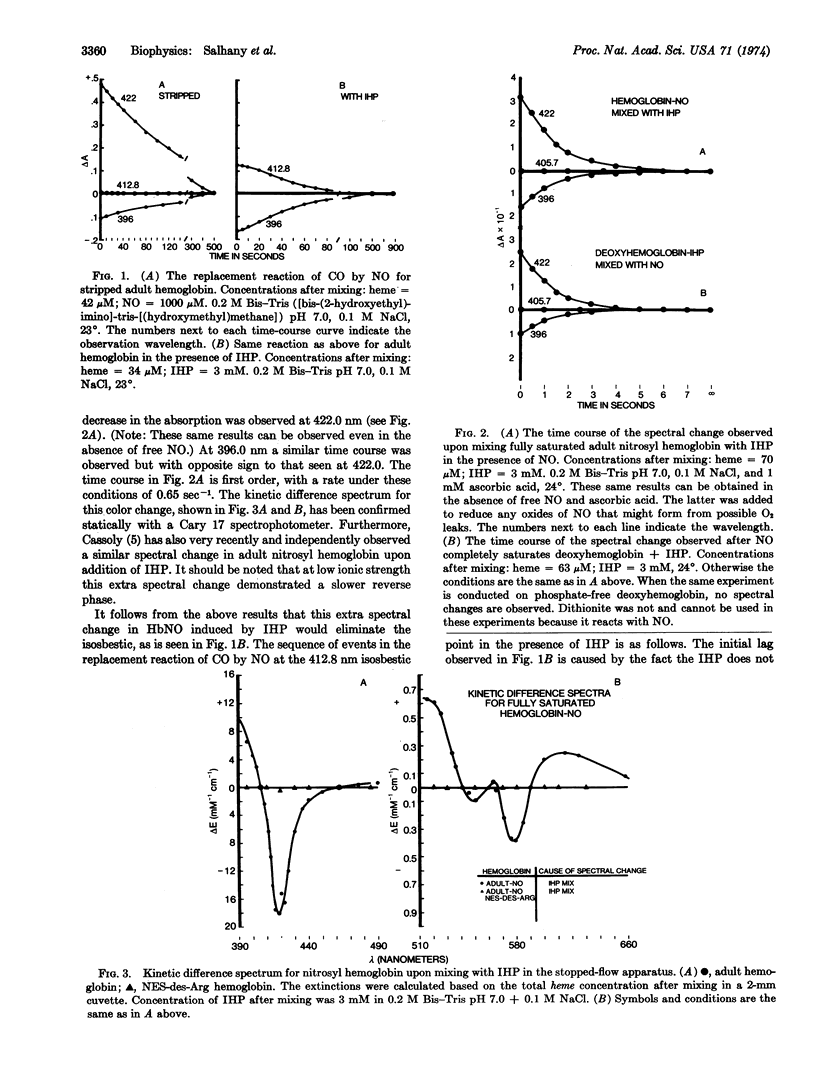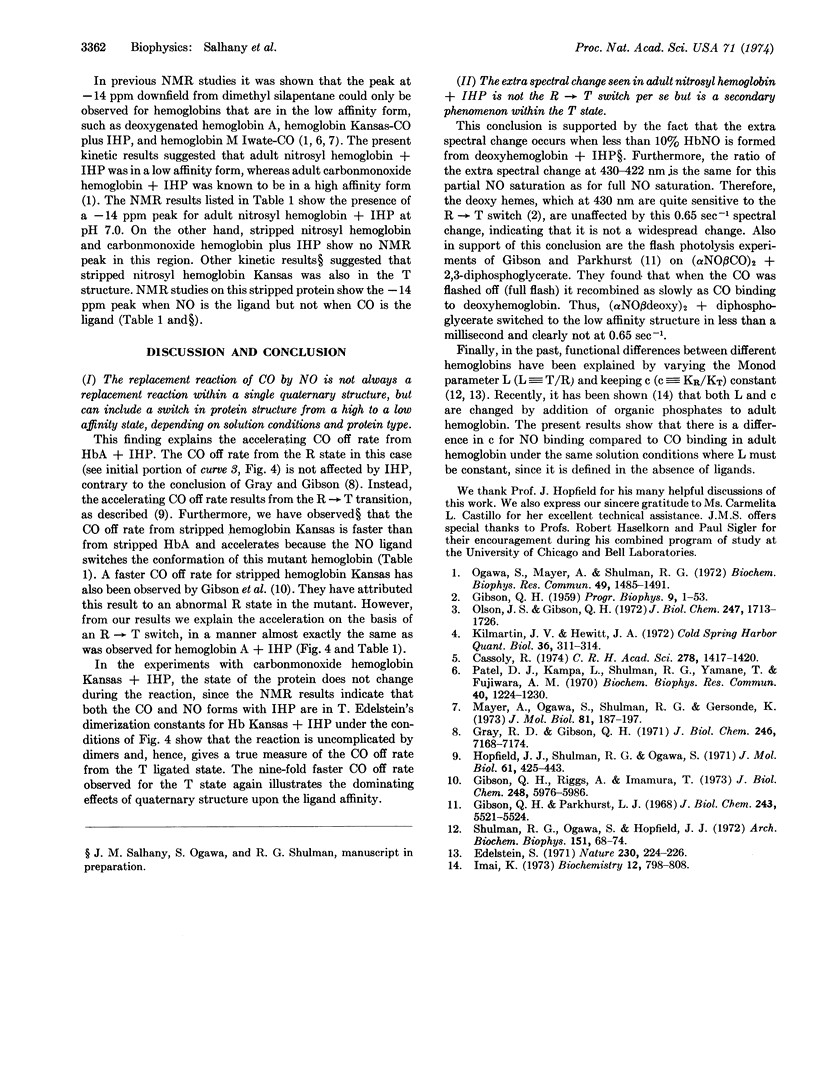Abstract
When NO replaces CO in hemoglobin A in the presence of inositol hexaphosphate, the time course is heterogeneous in contrast to stripped hemoglobin A, where it is homogeneous. If nitrosyl hemoglobin is mixed with inositol hexaphosphate in the stopped-flow apparatus, an extra spectral change is observed which is the cause of the spectral-kinetic heterogeneity in the CO replacement reaction. At wavelengths isosbestic for this extra spectral change, the time courses show an accelerating rate of CO dissociation. On the other hand, the same reaction for NES-des-Arg hemoglobin (hemoglobin reacted with N-ethylmaleimide and carboxypeptidase B) in the presence of inositol hexaphosphate is homogeneous and slow, and shows isosbesty. High-resolution nuclear magnetic resonance spectra indicate that adult nitrosyl hemoglobin in the presence of inositol hexaphosphate is in the low ligand affinity state, thus offering a structural basis for the acceleration observed in the rate of CO dissociation. Hemoglobin Kansas, in the presence of inositol hexaphosphate, which starts and finishes the reaction in the low affinity state, shows a rate of CO dissociation about nine times faster than stripped hemoglobin A. We conclude from these results that (i) the CO to NO replacement reaction can include a functionally important change in the overall conformation of fully liganded hemoglobin, depending on solution conditions and protein type; (ii) the extra spectral change observed for nitrosyl hemoglobin is not the functionally dominating conformational change, but is a secondary effect within the low ligand affinity protein structure; and (iii) the functional properties of heme ligands are largely controlled by two conformational states of the protein, as seen by nuclear magnetic resonance spectroscopy.
Keywords: CO replacement reaction, nuclear magnetic resonance, hemoglobin Kansas, inositol hexaphosphate, two-state model
Full text
PDF



Selected References
These references are in PubMed. This may not be the complete list of references from this article.
- Cassoly R. Relation entre spectre d'absorption optique et structure de la nitrosyl hémoglobine. C R Acad Sci Hebd Seances Acad Sci D. 1974 Mar 4;278(10):1417–1420. [PubMed] [Google Scholar]
- Edelstein S. J. Extensions of the allosteric model for haemoglobin. Nature. 1971 Mar 26;230(5291):224–227. doi: 10.1038/230224a0. [DOI] [PubMed] [Google Scholar]
- Gibson Q. H., Parkhurst L. J. Kinetic evidence for a tetrameric functional unit in hemoglobin. J Biol Chem. 1968 Oct 25;243(20):5521–5524. [PubMed] [Google Scholar]
- Gibson Q. H., Riggs A., Imamura T. Kinetic and equilibrium properties of hemoglobin Kansas. J Biol Chem. 1973 Sep 10;248(17):5976–5986. [PubMed] [Google Scholar]
- Gray R. D., Gibson Q. H. The effect of inositol hexaphosphate on the kinetics of CO and O 2 binding by human hemoglobin. J Biol Chem. 1971 Dec 10;246(23):7168–7174. [PubMed] [Google Scholar]
- Hopfield J. J., Shulman R. G., Ogawa S. An allosteric model of hemoglobin. I. Kinetics. J Mol Biol. 1971 Oct 28;61(2):425–443. doi: 10.1016/0022-2836(71)90391-3. [DOI] [PubMed] [Google Scholar]
- Imai K. Analyses of oxygen equilibria of native and chemically modified human adult hemoglobins on the basis of Adair's stepwise oxygenation theory and the allosteric model of Monod, Wyman, and Changeux. Biochemistry. 1973 Feb 27;12(5):798–808. doi: 10.1021/bi00729a003. [DOI] [PubMed] [Google Scholar]
- Kilmartin J. V., Hewitt J. A. The effect of removal of C-terminal residues on cooperative interactions in hemoglobin. Cold Spring Harb Symp Quant Biol. 1972;36:311–314. doi: 10.1101/sqb.1972.036.01.041. [DOI] [PubMed] [Google Scholar]
- Mayer A., Ogawa S., Schulman R. G., Gersonde K. High-resolution proton nuclear magnetic resonance studies of the quaternary state of hemoglobin M Iwate. J Mol Biol. 1973 Dec 5;81(2):187–197. doi: 10.1016/0022-2836(73)90188-5. [DOI] [PubMed] [Google Scholar]
- Ogawa S., Mayer A., Shulman R. G. High resolution proton magnetic resonance study of the two quaternary states in fully ligated hemoglobin Kansas. Biochem Biophys Res Commun. 1972 Dec 18;49(6):1485–1491. doi: 10.1016/0006-291x(72)90507-4. [DOI] [PubMed] [Google Scholar]
- Olson J. S., Gibson Q. H. The reaction of n-butyl isocyanide with human hemoglobin. II. The ligand-binding properties of the and chains within deoxyhemoglobin. J Biol Chem. 1972 Mar 25;247(6):1713–1726. [PubMed] [Google Scholar]
- Patel D. J., Kampa L., Shulman R. G., Yamane T., Fujiwara M. Proton NMR studies of hemoglobin in H2O. Biochem Biophys Res Commun. 1970 Sep 10;40(5):1224–1230. doi: 10.1016/0006-291x(70)90926-5. [DOI] [PubMed] [Google Scholar]
- Shulman R. G., Ogawa S., Hopfield J. J. An allosteric model of hemoglobin. II. The assumption of independent binding. Arch Biochem Biophys. 1972 Jul;151(1):68–74. doi: 10.1016/0003-9861(72)90474-2. [DOI] [PubMed] [Google Scholar]


